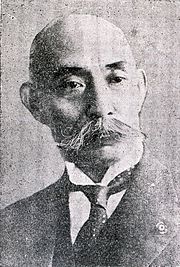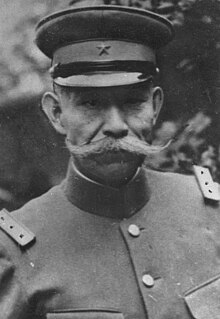Senjūrō Hayashi
This article needs additional citations for verification. (December 2007) |
Senjūrō Hayashi 林 銑十郎 | |
|---|---|
 | |
| Prime Minister of Japan | |
| In office 2 February 1937 – 4 June 1937 | |
| Monarch | Shōwa |
| Preceded by | Kōki Hirota |
| Succeeded by | Fumimaro Konoe |
| Personal details | |
| Born | 23 February 1876 Kanazawa, Japan |
| Died | 4 February 1943 (aged 66) Tokyo, Japan |
| Political party | Taisei Yokusankai (1940-1943) |
| Profession | General |

Senjūrō Hayashi (林 銑十郎, Hayashi Senjūrō, February 23, 1876 – February 4, 1943) was an Imperial Japanese Army commander of the Chosen Army of Japan in Korea during the Mukden Incident and the invasion of Manchuria, and a Japanese politician and the 33rd Prime Minister of Japan from February 2, 1937 to June 4, 1937.
Biography
Born in Ishikawa Prefecture, Hayashi's first major command from 1918 to 1920 was as commanding officer of the 57th Regiment, followed by a time in 1921 attached to the Technical Research Headquarters and as an acting Military Investigator. From 1921 to 1923 he was the head of the Preparatory Course at the Imperial Japanese Army Academy, followed by a time attached to the Inspectorate General of Military Training. From 1923 to 1924 he was the Army Representative to the League of Nations, followed by another stint attached to the Inspectorate General of Military Training from 1924 to 1925.
In 1925, Hayashi became the commanding Officer of the 2nd Brigade. In 1926 he was made Commandant of the Tokyo Bay Fortress. In 1927, he became the Commandant of the War College, followed in 1928 as Deputy Inspector-General of Military Training. Finally in 1929 he became the General Officer Commanding the Imperial Guards Division.
In 1930, Lieutenant-General Senjūrō Hayashi, was made Commander in Chief of the Chosen Army, in Korea. On the day after the Mukden Incident on September 19th, he ordered the IJA 20th Division to split its force, forming the 39th Mixed Brigade. The Japanese cabinet, however, disagreed with the army, suspecting that the Mukden Incident was a conspiracy by Japanese army officers. Without authorization by the Emperor, Hayashi ordered the 39th Mixed Brigade to depart that same day for Manchuria. The cabinet finally conceded the point to the military and the movement of the 39th Mixed Brigade from Korea was authorized on September 22nd.
Following his command in Korea, Hayashi was made Inspector-General of Military Training and a member of the Supreme War Council from 1932 to 1934. From 1934 to 1935 Hayashi was Army Minister, and from 1935 to 1936 again member of the Supreme War Council.
Hayashi was a supporter of Sadao Araki, along with Shigeru Honjo who was commander of the Kwantung Army. The Toseiha faction within the Imperial Japanese Army scored a victory in January 1934 when General Araki was forced to step down, after the excesses of the Kwantung Army, and his replacement was one of their own, General Hayashi. The struggle between the Toseiha and Kodoha factions continued below the surface of the government; and the war in North China carried on apace until February 1936.
Hayashi also promoted Fumimaro Konoye's doctrines, as a "right-winger" amongst the militarists, who approved of the "fiction" of democracy, and the Emperor's role with an "adviser group", againsy "left-winger" radical militarists. The latter, led by Kingoro Hashimoto, wanted a Military Shogunate (under the patronage of Baron Hiranuma).
Hayashi served as Prime Minister of Japan for a brief four month period in 1937. Later from 1940 to 1941, he was a Privy Councillor. He died in 1943.
